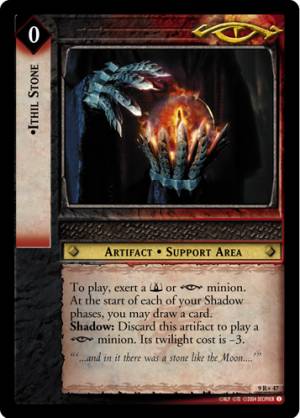| LotR TCG Wiki | → Card Sets: | All | 0 | 1 | 2 | 3 | 4 | 5 | 6 | 7 | 8 | 9 | 10 | 11 | 12 | 13 | 14 | 15 | 16 | 17 | 18 | 19 | → Forums: | TLHH | CC |
The Lord of the Rings TCG Wiki: Palantír
Palantír
Lore
Palantíri were seeing-stones of great power, introduced into Middle-earth when Elendil and his people fled the fall of Númenór. Elendil brought 7 of them with him, though many more were crafted by the Elves in the West. They were placed at strategic points around the kingdoms of Gondor and Arnor, where for many years they helped to keep the kingdoms together.
Palantíri were of fantastic tactical use due to their ability to show the user events happening at great distances. They could also be used to communicate, allowing kings and generals to coordinate and plan. Over the years, locations that held palantíri became points of conflict, and one by one each fell into conflict with most of them being lost: 2 in Arnor falling into the sea, 1 from Osgiliath lost to the River Anduin, and the palantír at Minas Ithil falling into Sauron's hands (at which event the tower was renamed Minas Morgul).
Due to Sauron's use of the Ithil stone, the others became extremely dangerous to use lest the user come into contact with the mind of Sauron himself. Sadly, this is exactly what happened during the War of the Ring: Saruman's fall completed when he used the Orthanc stone, and Denethor was driven mad at the visions of hopelessness he beheld in the Anor stone. Both of these were a great blow to the hope of the free peoples of Middle-earth; one demoralized the leader of the last bastion of Men, and the other began to actively work for their destruction.
But the palantíri also brought about Sauron's downfall. Palantíri could not show false images, but the interpretation of those images was left up to the user (which was how Sauron influenced others so; he showed seemingly endless images of his armies and thus his power), which was ultimately his undoing. Pippin's use of the Orthanc stone revealed himself to Sauron, who incorrectly assumed he held the One Ring. Later, when Aragorn used the Orthanc stone in a deliberate attempt to provoke Sauron by revealing the reforged Anduril, Sauron feared that he had recovered the One Ring, and so as a result, Sauron invaded Minas Tirith before his armies were ready. This allowed them to be defeated by the combined forces of Rohan, Minas Tirith, and the Rangers of the North.
The Ithil palantír was never recovered from the ruin of Barad-dur, and the Anor stone was ruined when Denethor committed suicide upon a funeral pyre while holding it (thereafter, the Anor palantír showed nothing but a pair of burning hands to those who looked). Aragorn used the Orthanc stone as King Elessar, and the other remaining stone was taken by the Elves into the West with the Elven Rings of Power.
Mechanics
Note: in spite of several cards representing palantíri as described above, this page only concerns itself with cards that have the actual item class of “Palantír”, which does not include Ithil Stone, Seeing Stone of Minas Anor, or Seeing Stone of Orthanc (which ironically can exist at the same time as The Palantír of Orthanc, and appears to be an oversight by Decipher). Nevertheless many tactics are similar between the both groups.
Palantíri represent the powerful seeing-stones described in the lore, above. As such, they typically grant the ability to look at your opponent's hand or deck, and in the case of Shadow versions, allow you to delay the use of the cards you reveal. As Artifacts, they are fairly safe to play as there are no cards which specifically target them.
If you find palantírs a nuisance, you can try the strategies employed on the artifact hate page, or simply cards that bar your opponent from looking at your hand, e.g. Erland, Advisor to Brand or No Business of Ours.
Artifacts with an Item Class of Palantir
Gandalf
Isengard
| Card Type | ||||||||||
|---|---|---|---|---|---|---|---|---|---|---|
| Layout Used: | Character Layout | Modifier Layout | Site Template | |||||||
| Alignment (Kind / Side) | Free Peoples | Companion | Ally | Follower | Artifact | Possession | The One Ring | Condition | Event | Site |
| Shadow | Minion | |||||||||
